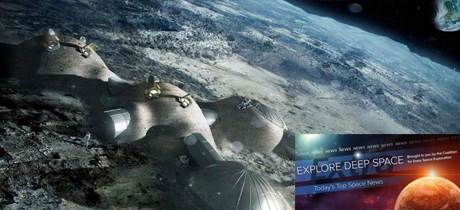In Today’s Deep Space Extra… The inaugural meeting of the re-established White House National Space Council identified ambitious goals across the space community, including a human return to the lunar surface. Now, it’s time for action.
Human Space Exploration
The Space Review (10/9): Words were plentiful throughout as the first 2 1/2 hour session of the re-established White House National Space Council chaired by Vice President Mike Pence drew to a close last week outside Washington. Now, it’s time for action regarding goals that range from the return of human explorers to the lunar surface enunciated by Pence, to cementing a solid lead in commercial space and addressing vulnerabilities in the realm of space national security. “What remains to be seen is how effective the council will be in its future meetings, held out of public view, to turn the visions laid out in this meeting into policies and programs” writes TSR editor Jeff Foust.
Space Science
Meet the X-ray visionary looking for signs of life on Mars
Wired.com (10/9): Australian astrobiologist Abigale Allwood invented PIXL, an X-ray device that can reveal the possible past presence of microbes in rocks. Her invention is headed for Mars aboard NASA’s Mars 2020 rover, as Allwood becomes the first woman to serve as an instrument principle investigator on a Mars mission.
Half the universe’s missing matter has just been finally found
New Scientist (10/9): Teams led by French and British scientists have uncovered what may be a massive amount of missing ordinary matter, or baryons, in the space between galaxies. The European Planck space observatory, operated between 2009 and 2013, was a key part of the possible discovery with its detection of the Sunyaev-Zel’dovich effect that occurs when light left over from the big bang passes through hot gas. The traveling luminescence scatters off electrons in the gas, leaving a “dim path in the cosmic microwave background,” the remnants of the big bang.
The missions proposed for the New Frontiers program
The Space Review (10/9): Where next for NASA’s New Frontiers planetary science initiative, one that can claim the New Horizons mission to Pluto: OSIRIS-REx, the nation’s first asteroid sample return attempt; and the Juno mission to Jupiter, as current namesakes? A dozen candidates are under discreet review, writes Van Kane, who follows the developments. Possible destinations include Venus, a comet sample return, Saturn’s moons Enceladus and Titan and the Earth’s moon.
Other News
Industry and government differ on future of FAA commercial space office
Space News (10/9): Findings from a new U.S. Government Accountability Office study are split on whether a federal authority that regulates commercial launch activities should remain under the jurisdiction of the FAA as the Office of Commercial Space Transportation or return to its former home as an independent authority under the Secretary of Transportation. FAA officials recommended status quo. Industry representatives favor the move. Concerns were expressed over staff resources, funding, government coordination and other bureaucratic issues.
State in talks to bring new space launch system to Space Coast
Florida Today (10/9): New high salaried jobs could follow as Space Florida negotiates with an existing but unidentified company with a high launch volume vision to locate on Florida’s Space Coast. Space Florida, a state economic development agency, has agreed to negotiate a joint $30 million investment strategy for the purchase of long lead equipment to start the enterprise.
Michael Griffin, former NASA head, leading candidate for R&E spot
Defense News (10/9): Mike Griffin, NASA’s administrator from 2005 to 2009, is in line to become the first Department of Defense undersecretary for research and engineering, according to the report. The position is to be established by the White House on February 1, in response to a Congressionally mandated reorganization.
Astronaut scholarship helps students envision futkure in space
Space.com (10/9): In 1984, the Astronaut Scholarship Foundation was established by surviving members of NASA’s first astronaut class, the Mercury 7. This year, University of Virginia scholarship recipient Steven Stetzler learned he could become an astronaut — if he wishes after meeting and speaking with former Apollo and shuttle era astronauts Al Worden and Catherine “Cady” Coleman.

